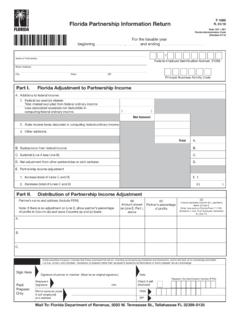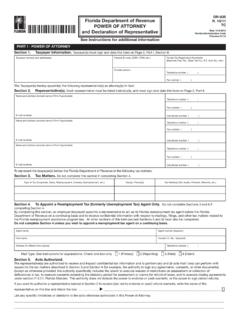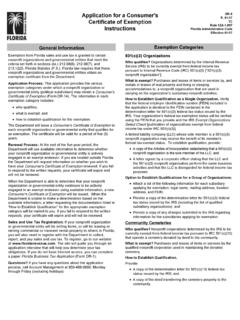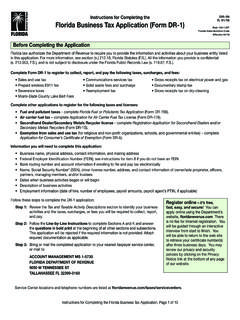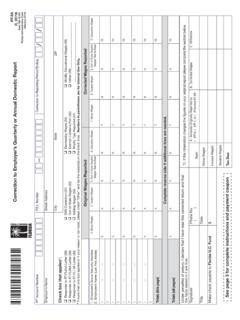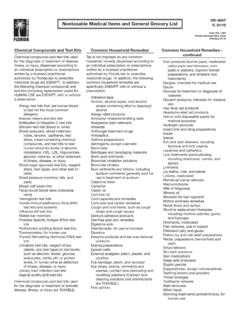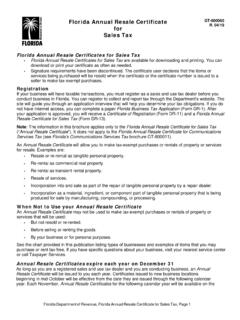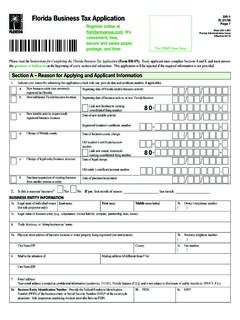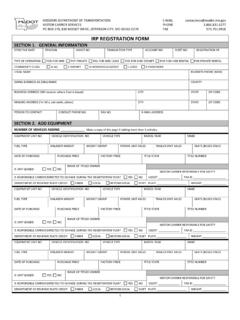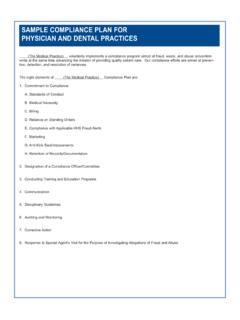Transcription of Employer Guide to Reemployment Tax - Florida Dept. of …
1 Department of Revenue, Employer Guide to Reemployment Tax, Page 1 Employer Guide to Reemployment Tax Table of Contents Introduction .. 2 Preface .. 2 Background .. 2 Classification of Workers .. 2 State Unemployment Tax Act (SUTA) .. 2 Federal Unemployment Tax Act (FUTA) .. 2 reporting Wages and Paying Reemployment Taxes .. 2 General Liability Requirements .. 2 Special Liability Requirements for Specific Employer Types .. 2 Nonprofit Employers .. 2 Governmental Entities .. 3 Indian Tribes .. 3 Reimbursement Option .. 3 Agricultural Employers .. 3 Domestic Employers .. 3 Voluntary Coverage .. 3 Employer -Employee Relationship .. 3 Employment Not Covered .. 4 Required Reports .. 5 Employer Registration Report .. 5 Successions .. 5 Employee Leasing Companies .. 5 Common Paymaster .. 6 Payrolling .. 6 Power of Attorney .. 6 Reemployment Tax Data Release Agreement (RT-19) .. 6 Tax and Wage reporting .
2 6 Where to Report Employees .. 6 Reciprocal Coverage Agreement (RCA) .. 7 Employer s Quarterly Report (RT-6) .. 7 Taxable Wage Base .. 8 Annual Filing Option .. 9 reporting Wages .. 9 Taxable Wages .. 9 Exempt Wages .. 10 Employer Multi-unit Reports .. 10 reporting Employees Contracted to Governmental or Nonprofit Educational Institutions .. 10 reporting Medium .. 11 Alternative Forms reporting .. 11 Electronic reporting and Payment Requirement .. 11 Penalty for Failure to File Electronically .. 11 Benefits of Filing and Paying Electronically .. 11 Timely reporting and Payment .. 11 Installment Payment Option .. 11 Penalty and Interest Charged for Late Filing and Payment .. 12 Assessments .. 12 Liens .. 12 Tax Rate Consequences .. 12 12 Adjusting/Correcting Your Report .. 12 new hire reporting .. 13 Inactivation of Account .. 13 Termination of Liability .. 13 When to Notify the Department.
3 13 Tax Audits and Required Employer 13 Audit Purpose .. 13 Records Required and Examined .. 13 Tax Rate .. 14 Regular .. 14 Successor Accounts .. 15 Mandatory Transfers .. 15 Federal Certification .. 15 Benefits .. 16 How Benefits Are Charged and Their Impact on Employers .. 16 Employer s Checklist for Compliance .. 16 Glossary .. 17 Contact Us .. 18 RT-800002 R. 04/18 Department of Revenue, Employer Guide to Reemployment Tax, Page 2 Introduction The Employer Guide to Reemployment Tax contains information employers need to comply with Florida s Reemployment Assistance Program Law. This Guide provides simplified explanations of the taxing procedures of the law. It is not intended to take precedence over the law or rules. Background Every state has an Unemployment Compensation Program. In Florida , legislation passed in 2012 changed the name of Florida s Unemployment Compensation Law to the Reemployment Assistance Program Law and directed the focus of the program to helping Florida s job seekers with becoming reemployed.
4 Reemployment benefits provide temporary income payments to make up part of the wages lost by workers who lose their jobs through no fault of their own, and who are able and available for work. It is job insurance paid for through a tax on employee wages. The Reemployment Assistance Program supports Reemployment services through local One-Stop Career Centers located throughout the state. The Federal Unemployment Tax Act provides for cooperation between state and federal governments in the establishment and administration of the Reemployment Assistance Program. Under this dual system, the Employer pays payroll taxes levied by both the state and federal governments. Classification of Workers Employers must understand how to determine whether a worker is an employee or an independent contractor, so they can correctly include all employees on their Employer s Quarterly Report (RT-6). One main distinction is that an employee is subject to the will and control of the Employer .
5 The Employer decides what work the employee will do and how the employee will do it. An officer of a corporation who performs services for the corporation is an employee, regardless of whether the officer receives a salary or other compensation. An independent contractor is not subject to the will and control of the Employer . The Employer can decide what results are expected from the independent contractor, but cannot control the methods used to accomplish those results. How the worker is treated, not a written contract or issuance of a 1099, determines whether the worker is an employee or an independent contractor. Misclassification of workers is not just a tax reporting issue; it also affects claims for Reemployment assistance benefits. If a person files a claim for benefits and the Employer has not been including the person on the quarterly report, this can cause a delay in benefit payments.
6 In addition, the intentional misclassification of a worker is a felony. State Unemployment Tax Act (SUTA) All Reemployment tax payments are deposited to the Unemployment Compensation Trust Fund for the sole purpose of paying benefits to eligible claimants. The Employer pays for this Reemployment Assistance Program as a cost of doing business. Workers do not pay any part of the Florida Reemployment tax and employers must not make payroll deductions for this purpose. Employers with stable employment records receive credit in reduced tax rates after a qualifying period. Federal Unemployment Tax Act (FUTA) Federal unemployment taxes are deposited to the FUTA Trust Fund and administered by the United States Department of Labor (USDOL) for funding the administrative costs of state Reemployment assistance, One-Stop Career Centers, and part of Labor Market Statistics Programs. The USDOL is also charged with monitoring state Reemployment Assistance Programs and can withhold funds from a state if it does not comply with federal standards.
7 reporting Wages and Paying Reemployment Taxes General Liability Requirements A business is liable for state Reemployment tax if, in the current or preceding calendar year, the Employer : (1) has paid at least $1,500 in wages in a calendar quarter; or (2) has had at least one employee for any portion of a day in 20 different weeks within the same calendar year; or (3) is liable for the Federal Unemployment Tax as a result of employment in another state. Special Liability Requirements for Specific Employer Types Nonprofit Employers Coverage is extended to employees of nonprofit organizations (such as religious, charitable, scientific, literary, or education groups) that employ four or more workers for any portion of a day in 20 different calendar weeks during the current or preceding calendar year. Exceptions to this coverage include churches and church schools. For purposes of the Florida Reemployment Assistance Program Law, a nonprofit organization is defined in section (s.)
8 3306(c)(8) of the Federal Unemployment Tax Act and s. 501(c)(3) of the Internal Revenue Code (IRC). Department of Revenue, Employer Guide to Reemployment Tax, Page 3 Governmental Entities Coverage is also extended to employees of the state of Florida and any city, county, or joint governmental unit. Indian Tribes Coverage is extended to employees for service performed in the employ of an Indian tribe, as defined by s. 3306(u) of the Federal Unemployment Tax Act, provided the service is excluded from employment as defined by that act solely by reason of s. 3306(c)(7) of the act and is not otherwise excluded from employment under the Florida Reemployment Assistance Program Law. For purposes of the Florida Reemployment Assistance Program Law, the exclusions from employment under s. (4), Florida Statutes ( ), apply to services performed in the employ of an Indian tribe. Reimbursement Option Nonprofit organizations, governmental entities, and Indian tribes, have the option of being taxpaying employers or reimbursing employers.
9 A reimbursing Employer is one who must pay the Unemployment Compensation Trust Fund on a dollar-for-dollar basis for the benefits paid to its former employees. Wage reports are submitted each quarter and the reimbursement of benefit charges are paid when billed. The Employer choosing the contributing method submits quarterly reports and tax due by applying their tax rate to taxable wages each quarter. Agricultural Employers Agricultural employers who, in the current or preceding year, paid $10,000 in cash wages in a calendar quarter or who employed five or more workers for any portion of a day in 20 different calendar weeks will become liable employers. Employers with a liability under this provision will also need to report any other employees (except domestic workers). The other employees must be reported even if their employment was less than 20 different weeks or the wages paid were less than $1,500 in any one quarter.
10 Domestic Employers Employers of employees who perform domestic services (maids, cooks, maintenance workers, chauffeurs, social secretaries, caretakers, private yacht crews, butlers, and house-parents) who, in the current or prior year, paid $1,000 in wages in any one calendar quarter are liable to report wages and pay Reemployment tax. Employers liable under this provision must not report general employees or agricultural employees unless they also establish liability under these other provisions of the law. Likewise, employers liable for their general employment must not report domestic workers or agricultural workers unless they also establish liability in these categories. In making a determination of liability, the wages paid in agricultural employment and in domestic employment must be counted separately from wages paid in other types of employment. The Coverage Requirements chart (see page 4) illustrates coverage requirements for four different employers (A, B, C, and D).
